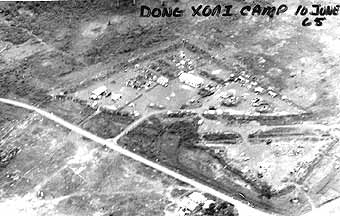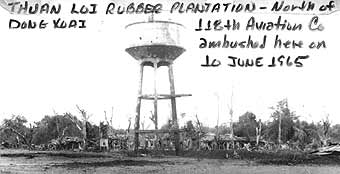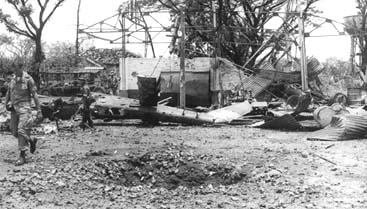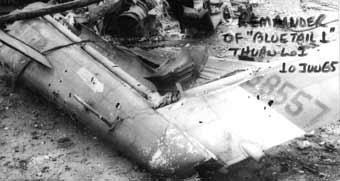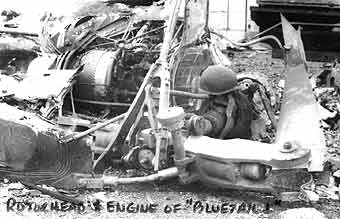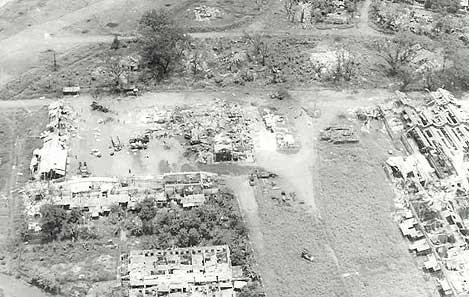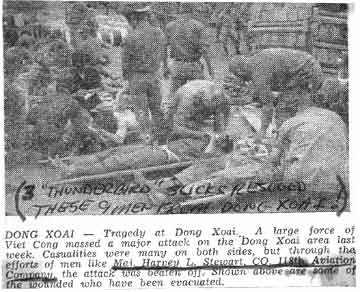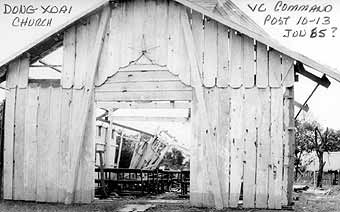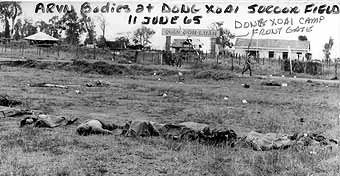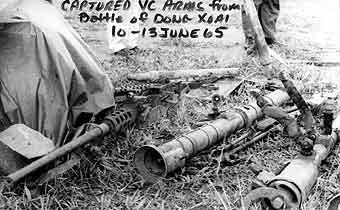BATTALION HISTORY
BATTLE OF DONG XOAI, 10-20 JUNE 1965
At 0100 hours, 10 June 1965, the 118th AHC was directed by the III
Corps Tactical Operation Center to send its standby fire team immediately
to Dong Xoai. They were told that the Dong Xoai Special Forces Camp had
been under extreme heavy mortar and small arms fire since midnight. The
fire team approached the town at 0130 hours and started making firing
passes once they were in position over the town. They were engaged by the
Viet Cong as soon as they began firing and the tracers from their guns
kept the enemy gunners aware of their position. Without the slightest
hesitation, the two armed helicopters kept up a steady stream of fire to
silence the enemy guns surrounding the Special Forces compound. Not until
after they had expended all their ammunition, and the fire team leaders
helicopter was hit by ground fire and the pilot wounded, did the two
helicopters leave the battle area.
At the time that the light fire team was closing Bien Hoa, III Corps
had decided to reinforce Dong Xoai by helicopters at first light with
Vietnamese infantry. At 0430 hours, flight crews of the 118th Aviation
Company were on flight line preparing for the combat assault at day light.
The town of Dong Xoai is situated at the most important road junction
in the heart of War Zone D. The United States Special Forces has
established a fortified compound and numerous strong points at strategic
locations taking the entire area under their command. Many parts of the
fortifications were still under construction when the first mortar shells
awoke the defenders.
At 0600 hours, 10 June 1965, all flyable 118th Aviation Company
aircraft departed Bien Hoa for a combat assault on Dong Xoai. The morale
of the company was high. They had grown fond of the Special Forces over
three years in which the company has served in Viet Nam. Many members of
the Special Forces B Detachment at Dong Xoai were friends of the company.
Although the tactical situation was extremely confused at Dong Xoai and
only scattered intelligence as to the enemy's strength and positions had
reached III corps, the 118th was ready to do anything within their
capability to aid the garrison under attack.
Phuoc Vinh, the nearest fortified town to Dong Xoai, was the staging
area. Elements of the 1st Battalion 7th Regiment ARVN, were going to make
the first assault with the 118th Aviation Company. Due to the urgency of
the situation, there was little time to gather data on the enemy
situation. The landing zone for the first assault was an open field two
miles north of Dong Xoai and next to the road that led to the Thanh Loi
Plantation. In case more ground troops were needed, two more landing zones
were chosen at suitable strategic areas in the vicinity of Dong Xoai.
The formation of 118th helicopters begin to receive fire as they
began to descend east of Dong Xoai. On final approach into the first
landing zone more fire was received. The flight held suppressive fire as
it was not known at the time whether friendly troops were in the area.
Seconds before the flight touched down the lead helicopter reported what
appeared to be friendly civilians waving to them from the edge of the
landing zone. The flight leader at once gave the order to the crews to
hold their fire because they were friendly civilians in the area. As soon
as the ships landed and the troops started unloading the civilians dove
into concealed fox holes where they had their weapons hidden and
immediately engaged the helicopters. Due to the fact the whole flight of
helicopters were low on fuel and were able to become airborne and out of
the range of small arms very quickly, no major damage to the flight
element resulted. However,with the departure of the helicopters, the Viet
Cong directed their fire on the assault troops in the landing zone. The
enemy had utilized the lack of intelligence on the part of the allied
forces to their best advantage at the crucial moment by deceiving the
heliborne force.Once the troops were committed, they were ambushed. The
Viet Cong, from their well prepared positions, systematically cut down the
lead elements of the 1st Battalion, 7th Regiment. Later when the battle
was over, it was disclosed that the 1st Battalion ceased to be a fighting
unit twenty minutes after it was committed into the Viet Cong trap.
When the 118th Aviation Company returned to Phuoc Vinh for more
soldiers and fuel, they were informed that the Viet Cong had anticipated
heliborne reinforcements for the surrounded Special Forces Camp were
employing strong units with heavy weapons and they intended to occupy Dong
Xoai. It was also disclosed that all the friendly troops had been forced
to reposition themselves inside the main compound that had the best
defensive capability.
When the 118th helicopters, loaded with soldiers of the remaining
elements of the 1st Battalion, 7th ARVN departed Phuoc Vinh they set their
organic armed helicopter platoon ahead of the flight to conduct a
reconnaissance of the intended landing zone. The armed fire zones made
repeated passes over the air strip at the Thanh Loi Plantation for traces
of the enemy concentrations but were able to find no evidence of the Viet
Cong using the plantation to stag attack on Dong Xoai. The fact that the
enemy up until the battle of Dong Xoai, had never used a plantation openly
as a headquarters and staging area caused the flight elements to hold
their suppressive fire power again as the helicopters approached to land.
Page 14
As the 118th Aviation Company's formation of fourteen troop
helicopter approached the landing strip a heard of cattle appeared and
moved up the strip to the intended landing area. The lead helicopter made
a decision to land the troops short of the original intended area. The
decision saved many lives. No sooner had the skids of the first helicopter
touched ground when a tremendous explosion was seen and heard and felt.
The enemy had detonated a hugh claymore mine planted at the original
landing area. The explosion of the mine was a signal. Within seconds of
the explosion, reports of automatic weapons are came from all members of
the formation. The soldiers and helicopters were caught in a hail storm of
bullets and exploding mortar rounds. The enemy fire was coming from
everywhere. In the well kept and beautiful plantation mansions they were
firing from windows and roofs. Among the rubber trees fire from concealed
bunkers and fox holes. At once, the armed escorts of the 118th Aviation
Company charged in and fired everything they had on both sides of the
helicopters still unloading their troops. At the same time the door
gunners of the troops carries were burning up the barrels of their machine
guns to suppress the enemy fire. It was only a few seconds since the
formation of the helicopters had landed, and yet it was already eternity
for the helicopter crews and the ARVN solders on the ground. Scores of the
brave little Vietnamese solders were falling in front of the eyes of the
helicopter crews as they watched them leap from the aircraft and fall as
enemy bullets slammed into their bodies. The helicopters were also
receiving heavy damage in those seconds on the ground. One of the troops
carriers had a mortar round explode right outside the cockpit causing it
to roll over immediately on its side. A split second later it exploded in
a ball of fire. The entire crew was killed. The remaining helicopters were
taking off at this time. All guns were firing, but the enemy fire was not
decreasing in intensity. From roof tops, windows doorways and trenches,
enemy bullets ripped into helicopters, When at last the whole formation
was out of range of the enemy weapons, only one helicopter reported
negative damage.
The Viet Cong had planned the attack on Dong Xoai with superb care.
There was no question left in anyone's mind that further heliborne
assaults into available landing zones would mean annihilation to the
majority of the ground troops and at tremendous risk to the aviation
elements. The 118th Aviation Company commander, in temporary command of
the entire Army Aviation efforts in Dong Xoai at the time ordered the
remaining elements with troops aboard back to the staging area. The last
helicopters to land at Phou Vinh were two armed helicopters from the
118th. The fire team remained over the battle area to act as radio
communication relay and fire support for the ground troops. The light fire
team had expended ammunition and had lost all communications with the
ground assault elements. It was not known at this time whether the Special
Forces compound was still holding out after almost 18 hours of continuous
attack.
The 118th Aviation Company's flight surgeon in charge of the medical
aid station at Phuoc Vinh was at the communication center requesting Air
Force C/130 transports to evacuate over a hundred wounded ARVN solders
when a relayed radio came through from Dong Xoai. It was one of the
Americans in the Dong Xoai Special Forces compound. The massage was tragic
and heroic. It said I am using my last battery for my radio and there is
no more ammunition; we are all wounded, some of the more serious wounded
are holding grenades with safety pins already pulled. The Viet Cong are
attacking in human waves. The last wave has been defeated but we are
expecting the next wave now.
The commander of the 118th who was present and heard the radio
message stood up and said "I am going in". With that he went to the parked
helicopters. Five other officers followed him and enlisted crew members
just climbed into their seats and waited for take off.
Three Helicopters departed Phouc Vinh for Dong Xoai to evacuate the
brave solders who were holding out to the last grenades. When they were
about to close Dong Xoai, A message to all air units in the Dong Xoai area
came over the radio. Dong Xoai was declared to a free strike area and
everything that moved would be bombed and strafed. The three helicopters,
nevertheless, pressed on without hesitation. Such was the moral present in
the 118th Aviation Company. Had there been need for the entire company to
go to Dong Xoai, the company would have volunteered to the man.
The 118th Aviation Company's own organic helicopters again played a
vital role in the successful execution of the mission. The armed escort
contacted Air Force fighter bombers in the area and ask for their fire
support. While the Air Force made their bomb runs over the town the armed
escorts went in from the south with all guns firing. One quarter of a mile
south of Dong Xoai compound was a water crossing. The Viet Cong had
concealed in the area two French armored cars that were captured earlier
in the battle. The armed helicopters were able to discover these mobile
weapons platforms during their low reconnaissance by fire and engaged them
with rockets. Their accurate fire effectively rendered the armored cars
incapable of further combat. Had the .50 cal. machine guns on those
armored cars not been put out of action, they would have taken a serious
toll of the troop carriers as they approached Dong Xoai.
The three troop carriers now moved in from the south. They were fast
and low and their door gunners were firing at any trace of Viet Cong
activity in range. There was constant firing and marking of targets all
along the flight route into the soccer field at Dong Xoai. With complete
surprise they touched down in the soccer
Page 15
field outside the Special Forces compound. Hastily, the Viet Cong
organized an attack. The crews reported enemy standing up on the compound
walls and firing down at the helicopters not more then fifty feet away.
While the helicopters were being hit from all directions and the door
gunners firing at point targets at close range, a crew chief leaped from
the helicopter and exposed himself completely to the enemy fire. He fired
a full magazine from his M14 at the compound entrance, then with disregard
for his own safety, fought his way into the compound and brought out the
last defenders of the outpost. For this act of valor the crew chief was
awarded the Distinguished Flying Cross. There were nine wounded Americans
and eight Vietnamese that were rescued from Dong Xoai that afternoon. They
were the last survivors of the original defenders of Dong Xoai.
At the debriefing held at Phuoc Vinh after the three helicopters had
returned, an interesting event came to everyone's attention. Within
seconds after the take off of the evacuation helicopters, the area where
they had landed exploded into mortar fire and it was raked with large
caliber machine gun fire in all quadrants. The fact that the helicopters
were able to successfully complete their mission can be attributed to the
element of surprise and the daring courage of the 118th helicopter crews.
The Viet Cong were evidently expecting a landing in the heart of Dong
Xoai. The extra seconds it took them to reposition their weapons to bear
down upon the helicopters that were making the evacuation allowed the
successful accomplishment of that daring mission. For their courage above
and beyond the call of duty, the three crews were decorated with one
Distinguished Service Cross, five Silver Stars, one Distinguished Flying
Cross and five Air Medals for heroism.
With the evacuation of the compound, the armed helicopters and Air
Force fighter bombers were free to make strike over the entire area. The
armed helicopters made strike after strike stopping only to rearm and
refuel. There was constant rain of fire from the sky in the whole area,
was the remark made by III Corps advisor in a 118th Aviation Company
command and control helicopter.
Late in the afternoon of 10 June 1965, the 52nd Ranger Battalion
arrived in Phuoc Vinh. Plans were immediately put into effect to take them
to Dong Xoai. Verbal orders were given to the aviation company commanders
while the crews made last minute checks on their helicopters prior to
becoming airborne. As the battalion-sized airmobile force neared Dong
Xoai, the final decision was to put the Rangers into the soccer field
where the successful evacuation was made a few hours before.
The 118th Aviation Company was again given the honor of leading the
combat assault. The flight route was the same as we used on the previous
evacuation mission. The helicopter slipped into the soccer field receiving
only scattered small arms as they landed. Once on the ground, however, the
Rangers were being shot down as they tried to move from the landing zone
to the compound and toward the center of town. The enemy, nevertheless,
must not have expected another daring assault that day and the air strikes
must have done their job well. The Viet Cong hastily prepared a defense
around the church in town witch had become their forward command post.
However, resistance was slowly put to an end, the compound was secured,
the town reoccupied. Dong Xoai was under control of the allied forces once
again when darkness came that day. The success of the last assault must be
attributed to the high degree of mobility and flexibility of our fighting
force, and the determination and willingness of our flight crews in their
helicopters.
The 118th Aviation Company returned to Bien Hoa after the lift of
52nd Ranger Battalion on 10 June 1965. The day of heavy fighting had
caused the loss of one entire helicopter crew and aircraft, plus almost
every helicopter having received bullet and shrapnel damage. Ten purple
hearts were awarded to members of the 118th Thunderbirds as a result of
this action.
During the night, more detailed intelligence of the enemy situation
was developed. The enemy had initially committed a full regiment of
regular troops with heavy supporting elements. Seven Viet Cong
anti-aircraft gun positions were destroyed by air in and around Dong Xoai.
Hundreds of mortar round from enemy mortars had destroyed practically
every fortification in the Special Forces Compound. But the devastation
air strikes and bombardments had caused the Viet Cong to suffer heavy
losses. During the day a second regiment with headquarters at the Thanh
Loi Plantation had to be committed for the attack on the compound. The
Viet Cong used human wave attacks on the compound was repeatedly beaten
back before the defenders were evacuated when their ammunition gave out.
However, even though the Viet Cong occupied all of Dong Xoai by late
afternoon 10 June 1965, it was not long before they were overwhelmed by
the allied forces. The arrival of the battle wise ARVN Ranger Battalion
was enough to break all organized resistance in the immediate vicinity of
the town.
The next morning 11 June 1965 118th Aviation Company was back in full
strength at Phouc Vinh. There was to be a battalion sized combat assault
with the 118th as the lead element. One hundred paratroopers of the 7th
airborne Battalion ARVN were lifted by the 118th into the soccer at Dong
Xoai. Although fire was expected by the aviation units, the armed escorts
flew low to draw fire from the enemy prior to the arrival of the troops
carrying helicopters, no enemy fire was received. The assault was
completed with the arrival of the remaining elements of the airmobile
battalion.
Large scale medical evacuation of ARVN casualties began immediately
after the air landing of the paratroopers on II June 1965. Hostilities
were coming to a halt in Dong Xoai except for isolated and rear guard
Page 16
action. The wounded were brought to the soccer field and loaded on
helicopters. There were almost no medical facilities at Dong Xoai all the
casualties were taken to Phuoc Vinh where the 118th Aviation Company
flight surgeon had set up a clearing station. The doctor had been working
for over forty hours with little rest when the mass evacuation of wounded
ARVN soldiers began. Helicopters continued to bring to Phuoc Vinh
seriously wounded and the medical personnel were overwhelmed with the
work. At one time there were over two hundred wounded awaiting treatment
at Phuoc Vinh. The medical personnel worked diligently and many soldiers
lives were saved.
On 12 June 1965, again staging from Phuoc Vinh, Republic of Vietnam,
the company lifted elements of the first battalion 48 Regiment ARVN. The
mission of the 1st Battalion was to reinforce the garrison already located
at Dong Xoai. The troop strength at Dong Xoai was approaching a thousand
and sufficient strength was present to secure the town.
Except for isolated snipers and enemy soldiers that were trapped in
the town itself, the maine body of the enemy had vanished. There was only
small units engagements on 12 June 1965. The 118th provided armed
helicopters support on a continuous basis to give fire support to the
ground forces. There was enemy fire but no casualties were sustained by
the flight crews. The armed helicopters also made an extensive
reconnaissance and search of the areas where the elements of the 1st
Battalion 7th Regiment were committed to battle on 10June 1965. They were
unable to detect any signs of the ARVN unit. The 118th thus prepared for
an assault on the following day.
After being in continuous operations for over 72 hours, the 118th
Aviation Company still provided the majority of the helicopters for the
assault on 13 June 1965. Despite the heavy casualties and excessive damage
to the helicopters, the morale of the company remained extremely high.
Many of the helicopters now carried volunteer gunners consisting of clerks
and cooks from the company.
The company went to Xuan Loc to pick up soldiers belonging to the
ARVN 43 Regiment. A hundred soldiers were lifted into a landing zone a
half mile north of the original assault area conducted on the first day of
the operation. From the landing area, the soldiers were to move through
the jungle and rubber trees to search for the troops that had disappeared
shortly after they were landed. During the conduct of the assault,
scattered small arms fire was received from the enemy hiding in the vast
Thanh Loi Plantation. The company did not sustain any damage to the
helicopters, nor any casualties. The enemy in this assault, turned out to
be the weather witch became to be a serious hazard to flight.
The lift of the 43 Regiment was conducted at night under minimum
lighting conditions. All during the daylight hours, fire teams searched
for the 7th Regiment soldiers. Finally the situation become too urgent not
to risk an air assault and ground search. The 118th was the only airmobile
company experienced in night assaults. The assault was accomplished
according to schedule. However due to the rapidly deteriorating weather on
the return flights, the pilots were unable to hold their formation and
helicopters were scattered all over "War Zone D". There was hidden
thunderstorms through out the area. Heavy rain reduced visibility to bare
minimum and winds gusting up to forty knots made any helicopter flying
extremely difficult. Only the high degree of training and professionalism
of the aviators prevented sure disaster and loss of crews and helicopters.
The flight returned to Bien Hoa individually with every helicopter
accounted for at 2330 hours. Many of the helicopters had but few minutes
of fuel remaining.
The Dong Xoai battle was to have a final chapter on 20 June 1965. On
that date the largest heliborne operation in the III Corps area was to
climax the closing of the battle. The 118th Aviation Company was again
chosen to lead the assault of seventy-seven troop carriers and forty armed
escorts. Staging for Hon Quan, the mission of the heliborne force was to
conduct combat assaults to the area north of Dong Xoai where
reconnaissance patrols and intelligence indicated a concentration of Viet
Cong forces in a rubber plantation it was believed that they were remnants
of the two enemy regiments that had attacked Dong Xoai. It appeared that
the enemy was now attempting to withdraw and break contact.
One thousand and eighty-nine paratroopers witch were the entire 3rd
and 8th ARVN Airborne Battalions, cream of the Vietnamese Army, were
landed by combat assault. Minor damages were sustained by a single
helicopter witch was caused by one enemy small arms bullet. There was no
other incidents of enemy resistance that day.
On 20 June 1965, the battle of Dong Xoai came to a close for the
118th Aviation Company.
Distinguished Unit Citation were awarded to the 145th C.A.B., 117th
AHC, 118th AHC, 120th AHC, 197th AHC, and Company A/501st Avn. BN. for
their actions between 10 June 1965 to 13 June 1965.
Page 17
At 0100 hours, 10 June 1965, the 118th AHC was directed by the III
Corps Tactical Operation Center to send its standby fire team immediately
to Dong Xoai. They were told that the Dong Xoai Special Forces Camp had
been under extreme heavy mortar and small arms fire since midnight. The
fire team approached the town at 0130 hours and started making firing
passes once they were in position over the town. They were engaged by the
Viet Cong as soon as they began firing and the tracers from their guns
kept the enemy gunners aware of their position. Without the slightest
hesitation, the two armed helicopters kept up a steady stream of fire to
silence the enemy guns surrounding the Special Forces compound. Not until
after they had expended all their ammunition, and the fire team leaders
helicopter was hit by ground fire and the pilot wounded, did the two
helicopters leave the battle area.
At the time that the light fire team was closing Bien Hoa, III Corps
had decided to reinforce Dong Xoai by helicopters at first light with
Vietnamese infantry. At 0430 hours, flight crews of the 118th Aviation
Company were on flight line preparing for the combat assault at day light.
The town of Dong Xoai is situated at the most important road junction
in the heart of War Zone D. The United States Special Forces has
established a fortified compound and numerous strong points at strategic
locations taking the entire area under their command. Many parts of the
fortifications were still under construction when the first mortar shells
awoke the defenders.
At 0600 hours, 10 June 1965, all flyable 118th Aviation Company
aircraft departed Bien Hoa for a combat assault on Dong Xoai. The morale
of the company was high. They had grown fond of the Special Forces over
three years in which the company has served in Viet Nam. Many members of
the Special Forces B Detachment at Dong Xoai were friends of the company.
Although the tactical situation was extremely confused at Dong Xoai and
only scattered intelligence as to the enemy's strength and positions had
reached III corps, the 118th was ready to do anything within their
capability to aid the garrison under attack.
Phuoc Vinh, the nearest fortified town to Dong Xoai, was the staging
area. Elements of the 1st Battalion 7th Regiment ARVN, were going to make
the first assault with the 118th Aviation Company. Due to the urgency of
the situation, there was little time to gather data on the enemy
situation. The landing zone for the first assault was an open field two
miles north of Dong Xoai and next to the road that led to the Thanh Loi
Plantation. In case more ground troops were needed, two more landing zones
were chosen at suitable strategic areas in the vicinity of Dong Xoai.
The formation of 118th helicopters begin to receive fire as they
began to descend east of Dong Xoai. On final approach into the first
landing zone more fire was received. The flight held suppressive fire as
it was not known at the time whether friendly troops were in the area.
Seconds before the flight touched down the lead helicopter reported what
appeared to be friendly civilians waving to them from the edge of the
landing zone. The flight leader at once gave the order to the crews to
hold their fire because they were friendly civilians in the area. As soon
as the ships landed and the troops started unloading the civilians dove
into concealed fox holes where they had their weapons hidden and
immediately engaged the helicopters. Due to the fact the whole flight of
helicopters were low on fuel and were able to become airborne and out of
the range of small arms very quickly, no major damage to the flight
element resulted. However,with the departure of the helicopters, the Viet
Cong directed their fire on the assault troops in the landing zone. The
enemy had utilized the lack of intelligence on the part of the allied
forces to their best advantage at the crucial moment by deceiving the
heliborne force.Once the troops were committed, they were ambushed. The
Viet Cong, from their well prepared positions, systematically cut down the
lead elements of the 1st Battalion, 7th Regiment. Later when the battle
was over, it was disclosed that the 1st Battalion ceased to be a fighting
unit twenty minutes after it was committed into the Viet Cong trap.
When the 118th Aviation Company returned to Phuoc Vinh for more
soldiers and fuel, they were informed that the Viet Cong had anticipated
heliborne reinforcements for the surrounded Special Forces Camp were
employing strong units with heavy weapons and they intended to occupy Dong
Xoai. It was also disclosed that all the friendly troops had been forced
to reposition themselves inside the main compound that had the best
defensive capability.
When the 118th helicopters, loaded with soldiers of the remaining
elements of the 1st Battalion, 7th ARVN departed Phuoc Vinh they set their
organic armed helicopter platoon ahead of the flight to conduct a
reconnaissance of the intended landing zone. The armed fire zones made
repeated passes over the air strip at the Thanh Loi Plantation for traces
of the enemy concentrations but were able to find no evidence of the Viet
Cong using the plantation to stag attack on Dong Xoai. The fact that the
enemy up until the battle of Dong Xoai, had never used a plantation openly
as a headquarters and staging area caused the flight elements to hold
their suppressive fire power again as the helicopters approached to land.
Page 14
As the 118th Aviation Company's formation of fourteen troop
helicopter approached the landing strip a heard of cattle appeared and
moved up the strip to the intended landing area. The lead helicopter made
a decision to land the troops short of the original intended area. The
decision saved many lives. No sooner had the skids of the first helicopter
touched ground when a tremendous explosion was seen and heard and felt.
The enemy had detonated a hugh claymore mine planted at the original
landing area. The explosion of the mine was a signal. Within seconds of
the explosion, reports of automatic weapons are came from all members of
the formation. The soldiers and helicopters were caught in a hail storm of
bullets and exploding mortar rounds. The enemy fire was coming from
everywhere. In the well kept and beautiful plantation mansions they were
firing from windows and roofs. Among the rubber trees fire from concealed
bunkers and fox holes. At once, the armed escorts of the 118th Aviation
Company charged in and fired everything they had on both sides of the
helicopters still unloading their troops. At the same time the door
gunners of the troops carries were burning up the barrels of their machine
guns to suppress the enemy fire. It was only a few seconds since the
formation of the helicopters had landed, and yet it was already eternity
for the helicopter crews and the ARVN solders on the ground. Scores of the
brave little Vietnamese solders were falling in front of the eyes of the
helicopter crews as they watched them leap from the aircraft and fall as
enemy bullets slammed into their bodies. The helicopters were also
receiving heavy damage in those seconds on the ground. One of the troops
carriers had a mortar round explode right outside the cockpit causing it
to roll over immediately on its side. A split second later it exploded in
a ball of fire. The entire crew was killed. The remaining helicopters were
taking off at this time. All guns were firing, but the enemy fire was not
decreasing in intensity. From roof tops, windows doorways and trenches,
enemy bullets ripped into helicopters, When at last the whole formation
was out of range of the enemy weapons, only one helicopter reported
negative damage.
The Viet Cong had planned the attack on Dong Xoai with superb care.
There was no question left in anyone's mind that further heliborne
assaults into available landing zones would mean annihilation to the
majority of the ground troops and at tremendous risk to the aviation
elements. The 118th Aviation Company commander, in temporary command of
the entire Army Aviation efforts in Dong Xoai at the time ordered the
remaining elements with troops aboard back to the staging area. The last
helicopters to land at Phou Vinh were two armed helicopters from the
118th. The fire team remained over the battle area to act as radio
communication relay and fire support for the ground troops. The light fire
team had expended ammunition and had lost all communications with the
ground assault elements. It was not known at this time whether the Special
Forces compound was still holding out after almost 18 hours of continuous
attack.
The 118th Aviation Company's flight surgeon in charge of the medical
aid station at Phuoc Vinh was at the communication center requesting Air
Force C/130 transports to evacuate over a hundred wounded ARVN solders
when a relayed radio came through from Dong Xoai. It was one of the
Americans in the Dong Xoai Special Forces compound. The massage was tragic
and heroic. It said I am using my last battery for my radio and there is
no more ammunition; we are all wounded, some of the more serious wounded
are holding grenades with safety pins already pulled. The Viet Cong are
attacking in human waves. The last wave has been defeated but we are
expecting the next wave now.
The commander of the 118th who was present and heard the radio
message stood up and said "I am going in". With that he went to the parked
helicopters. Five other officers followed him and enlisted crew members
just climbed into their seats and waited for take off.
Three Helicopters departed Phouc Vinh for Dong Xoai to evacuate the
brave solders who were holding out to the last grenades. When they were
about to close Dong Xoai, A message to all air units in the Dong Xoai area
came over the radio. Dong Xoai was declared to a free strike area and
everything that moved would be bombed and strafed. The three helicopters,
nevertheless, pressed on without hesitation. Such was the moral present in
the 118th Aviation Company. Had there been need for the entire company to
go to Dong Xoai, the company would have volunteered to the man.
The 118th Aviation Company's own organic helicopters again played a
vital role in the successful execution of the mission. The armed escort
contacted Air Force fighter bombers in the area and ask for their fire
support. While the Air Force made their bomb runs over the town the armed
escorts went in from the south with all guns firing. One quarter of a mile
south of Dong Xoai compound was a water crossing. The Viet Cong had
concealed in the area two French armored cars that were captured earlier
in the battle. The armed helicopters were able to discover these mobile
weapons platforms during their low reconnaissance by fire and engaged them
with rockets. Their accurate fire effectively rendered the armored cars
incapable of further combat. Had the .50 cal. machine guns on those
armored cars not been put out of action, they would have taken a serious
toll of the troop carriers as they approached Dong Xoai.
The three troop carriers now moved in from the south. They were fast
and low and their door gunners were firing at any trace of Viet Cong
activity in range. There was constant firing and marking of targets all
along the flight route into the soccer field at Dong Xoai. With complete
surprise they touched down in the soccer
Page 15
field outside the Special Forces compound. Hastily, the Viet Cong
organized an attack. The crews reported enemy standing up on the compound
walls and firing down at the helicopters not more then fifty feet away.
While the helicopters were being hit from all directions and the door
gunners firing at point targets at close range, a crew chief leaped from
the helicopter and exposed himself completely to the enemy fire. He fired
a full magazine from his M14 at the compound entrance, then with disregard
for his own safety, fought his way into the compound and brought out the
last defenders of the outpost. For this act of valor the crew chief was
awarded the Distinguished Flying Cross. There were nine wounded Americans
and eight Vietnamese that were rescued from Dong Xoai that afternoon. They
were the last survivors of the original defenders of Dong Xoai.
At the debriefing held at Phuoc Vinh after the three helicopters had
returned, an interesting event came to everyone's attention. Within
seconds after the take off of the evacuation helicopters, the area where
they had landed exploded into mortar fire and it was raked with large
caliber machine gun fire in all quadrants. The fact that the helicopters
were able to successfully complete their mission can be attributed to the
element of surprise and the daring courage of the 118th helicopter crews.
The Viet Cong were evidently expecting a landing in the heart of Dong
Xoai. The extra seconds it took them to reposition their weapons to bear
down upon the helicopters that were making the evacuation allowed the
successful accomplishment of that daring mission. For their courage above
and beyond the call of duty, the three crews were decorated with one
Distinguished Service Cross, five Silver Stars, one Distinguished Flying
Cross and five Air Medals for heroism.
With the evacuation of the compound, the armed helicopters and Air
Force fighter bombers were free to make strike over the entire area. The
armed helicopters made strike after strike stopping only to rearm and
refuel. There was constant rain of fire from the sky in the whole area,
was the remark made by III Corps advisor in a 118th Aviation Company
command and control helicopter.
Late in the afternoon of 10 June 1965, the 52nd Ranger Battalion
arrived in Phuoc Vinh. Plans were immediately put into effect to take them
to Dong Xoai. Verbal orders were given to the aviation company commanders
while the crews made last minute checks on their helicopters prior to
becoming airborne. As the battalion-sized airmobile force neared Dong
Xoai, the final decision was to put the Rangers into the soccer field
where the successful evacuation was made a few hours before.
The 118th Aviation Company was again given the honor of leading the
combat assault. The flight route was the same as we used on the previous
evacuation mission. The helicopter slipped into the soccer field receiving
only scattered small arms as they landed. Once on the ground, however, the
Rangers were being shot down as they tried to move from the landing zone
to the compound and toward the center of town. The enemy, nevertheless,
must not have expected another daring assault that day and the air strikes
must have done their job well. The Viet Cong hastily prepared a defense
around the church in town witch had become their forward command post.
However, resistance was slowly put to an end, the compound was secured,
the town reoccupied. Dong Xoai was under control of the allied forces once
again when darkness came that day. The success of the last assault must be
attributed to the high degree of mobility and flexibility of our fighting
force, and the determination and willingness of our flight crews in their
helicopters.
The 118th Aviation Company returned to Bien Hoa after the lift of
52nd Ranger Battalion on 10 June 1965. The day of heavy fighting had
caused the loss of one entire helicopter crew and aircraft, plus almost
every helicopter having received bullet and shrapnel damage. Ten purple
hearts were awarded to members of the 118th Thunderbirds as a result of
this action.
During the night, more detailed intelligence of the enemy situation
was developed. The enemy had initially committed a full regiment of
regular troops with heavy supporting elements. Seven Viet Cong
anti-aircraft gun positions were destroyed by air in and around Dong Xoai.
Hundreds of mortar round from enemy mortars had destroyed practically
every fortification in the Special Forces Compound. But the devastation
air strikes and bombardments had caused the Viet Cong to suffer heavy
losses. During the day a second regiment with headquarters at the Thanh
Loi Plantation had to be committed for the attack on the compound. The
Viet Cong used human wave attacks on the compound was repeatedly beaten
back before the defenders were evacuated when their ammunition gave out.
However, even though the Viet Cong occupied all of Dong Xoai by late
afternoon 10 June 1965, it was not long before they were overwhelmed by
the allied forces. The arrival of the battle wise ARVN Ranger Battalion
was enough to break all organized resistance in the immediate vicinity of
the town.
The next morning 11 June 1965 118th Aviation Company was back in full
strength at Phouc Vinh. There was to be a battalion sized combat assault
with the 118th as the lead element. One hundred paratroopers of the 7th
airborne Battalion ARVN were lifted by the 118th into the soccer at Dong
Xoai. Although fire was expected by the aviation units, the armed escorts
flew low to draw fire from the enemy prior to the arrival of the troops
carrying helicopters, no enemy fire was received. The assault was
completed with the arrival of the remaining elements of the airmobile
battalion.
Large scale medical evacuation of ARVN casualties began immediately
after the air landing of the paratroopers on II June 1965. Hostilities
were coming to a halt in Dong Xoai except for isolated and rear guard
Page 16
action. The wounded were brought to the soccer field and loaded on
helicopters. There were almost no medical facilities at Dong Xoai all the
casualties were taken to Phuoc Vinh where the 118th Aviation Company
flight surgeon had set up a clearing station. The doctor had been working
for over forty hours with little rest when the mass evacuation of wounded
ARVN soldiers began. Helicopters continued to bring to Phuoc Vinh
seriously wounded and the medical personnel were overwhelmed with the
work. At one time there were over two hundred wounded awaiting treatment
at Phuoc Vinh. The medical personnel worked diligently and many soldiers
lives were saved.
On 12 June 1965, again staging from Phuoc Vinh, Republic of Vietnam,
the company lifted elements of the first battalion 48 Regiment ARVN. The
mission of the 1st Battalion was to reinforce the garrison already located
at Dong Xoai. The troop strength at Dong Xoai was approaching a thousand
and sufficient strength was present to secure the town.
Except for isolated snipers and enemy soldiers that were trapped in
the town itself, the maine body of the enemy had vanished. There was only
small units engagements on 12 June 1965. The 118th provided armed
helicopters support on a continuous basis to give fire support to the
ground forces. There was enemy fire but no casualties were sustained by
the flight crews. The armed helicopters also made an extensive
reconnaissance and search of the areas where the elements of the 1st
Battalion 7th Regiment were committed to battle on 10June 1965. They were
unable to detect any signs of the ARVN unit. The 118th thus prepared for
an assault on the following day.
After being in continuous operations for over 72 hours, the 118th
Aviation Company still provided the majority of the helicopters for the
assault on 13 June 1965. Despite the heavy casualties and excessive damage
to the helicopters, the morale of the company remained extremely high.
Many of the helicopters now carried volunteer gunners consisting of clerks
and cooks from the company.
The company went to Xuan Loc to pick up soldiers belonging to the
ARVN 43 Regiment. A hundred soldiers were lifted into a landing zone a
half mile north of the original assault area conducted on the first day of
the operation. From the landing area, the soldiers were to move through
the jungle and rubber trees to search for the troops that had disappeared
shortly after they were landed. During the conduct of the assault,
scattered small arms fire was received from the enemy hiding in the vast
Thanh Loi Plantation. The company did not sustain any damage to the
helicopters, nor any casualties. The enemy in this assault, turned out to
be the weather witch became to be a serious hazard to flight.
The lift of the 43 Regiment was conducted at night under minimum
lighting conditions. All during the daylight hours, fire teams searched
for the 7th Regiment soldiers. Finally the situation become too urgent not
to risk an air assault and ground search. The 118th was the only airmobile
company experienced in night assaults. The assault was accomplished
according to schedule. However due to the rapidly deteriorating weather on
the return flights, the pilots were unable to hold their formation and
helicopters were scattered all over "War Zone D". There was hidden
thunderstorms through out the area. Heavy rain reduced visibility to bare
minimum and winds gusting up to forty knots made any helicopter flying
extremely difficult. Only the high degree of training and professionalism
of the aviators prevented sure disaster and loss of crews and helicopters.
The flight returned to Bien Hoa individually with every helicopter
accounted for at 2330 hours. Many of the helicopters had but few minutes
of fuel remaining.
The Dong Xoai battle was to have a final chapter on 20 June 1965. On
that date the largest heliborne operation in the III Corps area was to
climax the closing of the battle. The 118th Aviation Company was again
chosen to lead the assault of seventy-seven troop carriers and forty armed
escorts. Staging for Hon Quan, the mission of the heliborne force was to
conduct combat assaults to the area north of Dong Xoai where
reconnaissance patrols and intelligence indicated a concentration of Viet
Cong forces in a rubber plantation it was believed that they were remnants
of the two enemy regiments that had attacked Dong Xoai. It appeared that
the enemy was now attempting to withdraw and break contact.
One thousand and eighty-nine paratroopers witch were the entire 3rd
and 8th ARVN Airborne Battalions, cream of the Vietnamese Army, were
landed by combat assault. Minor damages were sustained by a single
helicopter witch was caused by one enemy small arms bullet. There was no
other incidents of enemy resistance that day.
On 20 June 1965, the battle of Dong Xoai came to a close for the
118th Aviation Company.
Distinguished Unit Citation were awarded to the 145th C.A.B., 117th
AHC, 118th AHC, 120th AHC, 197th AHC, and Company A/501st Avn. BN. for
their actions between 10 June 1965 to 13 June 1965.
